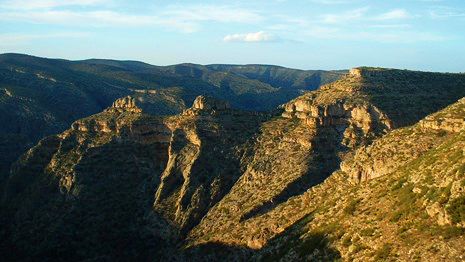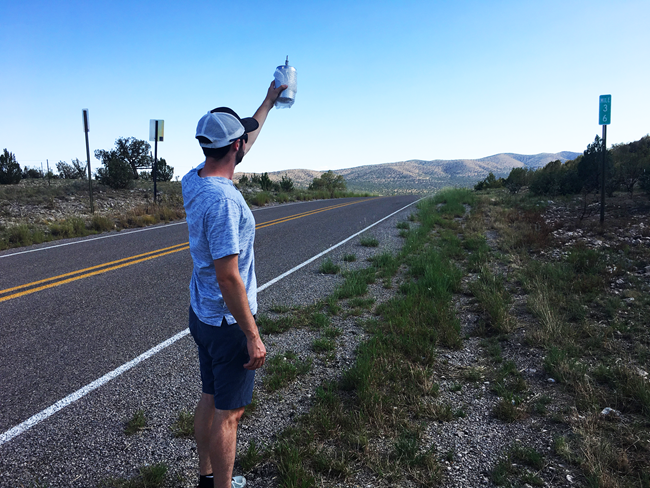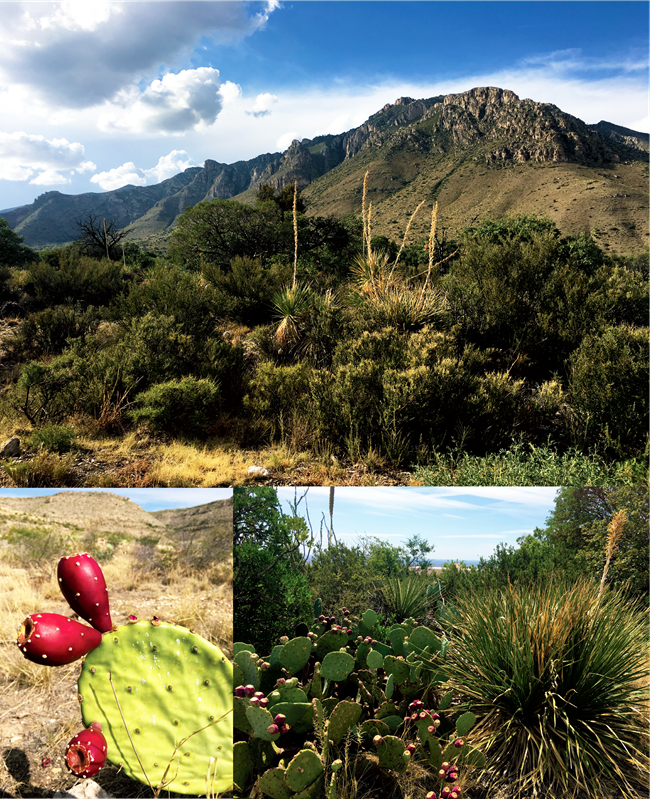Last updated: May 12, 2020
Article
Student Journal: Studying the Air at Carlsbad Caverns National Park

Article prepared by:
Jeremy McClung, NPS Air Resources Division Student Internfrom the University of Colorado, Denver.

To help study the air quality at Carlsbad Caverns National Park (NP), I drove five hours away from the park and posed like the Statue of Liberty on the side of the road in Nowhere, Texas. How in the world does this help study the air quality at the park, you ask? Let me explain. A lot of air pollution in national parks comes from sources well outside of park boundaries. At Carlsbad Caverns NP, regional oil and gas operations emit pollutants that can be transported to the park, impacting air quality and things that are affected by air quality like haze and plant health. I am posing like the Statue of Liberty because the canister in my hand is collecting an air sample that will later be analyzed in a laboratory to figure out what is in the air. Understanding air quality in the park is important for visitor health as well as plants and soils.

The NPS is collaborating with Colorado State University (CSU) on an air quality study at Carlsbad Caverns NP to study how much pollution the park receives and where it comes from. Collecting air samples around the park allows air quality scientists to learn more about the directions that the main sources of pollution are coming from. Previous research here suggests that oil and gas operations are impacting air quality, resulting in higher ozone levels and other air pollutants within the park. Air quality data helps us learn more about this. I am an intern at the National Park Service, Air Resources Division, and I had the opportunity to take an inside look into air quality research by visiting with the team of researchers at Carlsbad Caverns NP last summer.
Day 1

The trip began with the 600-mile drive south from the NPS office in Lakewood, Colorado to the research station in Carlsbad Caverns NP, New Mexico. On this drive, I was able to pick the brain of an NPS atmospheric chemist, Dr. Tony Prenni, who helped organize the study. He explained that the 2019 study we were working on was a follow-up to a 2017 air quality study of a group of western national parks. The 2017 study found unexpectedly high ground-level ozone measurements at Carlsbad Caverns NP. Ground-level ozone can have negative impacts on the local ecosystem and human respiratory health. Following the 2017 study, the NPS wanted to collect more continuous data to better understand how this pollution forms and where it comes from.

When we finally arrived at the research station, I was amazed by the number of instruments required for the study. There were four large rooms, all filled to the brim with equipment. Each instrument was used to study a different air quality parameter. Some of the parameters, like ozone, were measured by several different methods. A goal of the study was to get as much high-resolution data as possible to help better understand all of the factors causing ozone formation at Carlsbad. The researchers told me that it took several different trips just to get all of the equipment down there and that the equipment required so much power that the park added a custom power setup with three extra sets of outlets to support the research.
The setup is not the only tough part about air quality research. The equipment requires constant maintenance to ensure valid data collection. The researchers put in an incredible amount of time into keeping the whole operation running; while I was there, they never spent less than 11-12 hours at the lab. Every night, after we got back from dinner and I was excited to finally get to rest, the team would spend several more hours closing up the monitoring station and backing up the data.
Day 2

On the second day of my trip, I got to visit the spectacular Carlsbad Caverns. As I walked along the miles of paved trails though the caves, I marveled at the grandeur of countless cave decorations, each with its own unique formation. The caverns are so vast that it is almost too much to take in. Everywhere you look, there are intricate, beautiful details in the colorful formations. I didn’t have time to take an “off-road” tour into the unpaved portions of the caves, but I was lucky enough to tour through the lowest portion of the cave, the King’s Palace. This section of the caverns is known for its incredible formations, which include draperies, soda straws, and vibrant columns.

In addition to the natural wonder of the caves, I think my favorite part of Carlsbad Caverns was the lighting throughout the underground tunnels. The lights were placed strategically to highlight what needed attention drawn to it, while leaving enough darkness to keep a natural beauty to the caves. The day ended by watching the daily spectacle of bats leaving for their evening hunt through the entrance of the caverns. Every night at dusk, nearly half a million bats swarm out of the caves in a biological tornado, spiraling towards the sunset in a magnificent display.
Day 3–5

The next day, I began my own contribution to the air quality research at the park. As mentioned above, my job was to collect air samples outside the park boundaries. Every day for the next three days, I would ride with Dr. Prenni on six to nine-hour pre-planned loops from Carlsbad Caverns NP towards potential air pollution sources. Every 30–45 minutes, we would pull off of the main road and collect a sample. At each stop I would pose like the Statue of Liberty and open the cap to the canister. Removing this cap allowed for the vacuum-sealed canister to sample enough air to fill all of the way, until the pressure gradient was satisfied. Every time we took a sample, we noted the time, the GPS coordinates, and the direction of the prevailing wind. After the trip, all of these air samples were sent to a laboratory and analyzed for a wide array of volatile organic compounds, which impact ozone formation and serve as markers for pollutant sources. When these measurements are mapped out across southeastern New Mexico and west Texas, and are combined with the measurements at Carlsbad Caverns NP, the researchers hope to see gradients of pollution leading to the park and identify the main contributors.
Day 6

The sixth day of the trip brought an end to my adventure and it was sad to leave such a beautiful place. While most think of Carlsbad Caverns NP as an amazing web of caves, the miles of canyons and desert landscape leading from the park entrance to the visitor center have their own majesty that I have come to miss. We drove off towards the airport in El Paso, Texas, taking one last set of air canister samples along the way. The air quality study ended just a few weeks later, in September of 2019. With such an enormous dataset, the results are still being processed, but will soon be available to the public. Stay tuned for the final results of this incredible study!
